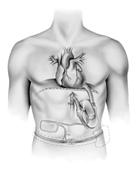
More than six million American adults — including many nursing home residents — suffer from heart failure. But, while the prevalence of this disease has increased over time, there are signs that technology-driven devices and products are beginning to make a positive difference.
“The prognosis for patients with heart failure has steadily improved,” said Gregg C. Fonarow, M.D, chairman of American Heart Association Hospital Accreditation Science Committee and professor of cardiovascular medicine at the University of California, Los Angeles. “Used appropriately, available medical and device therapies are even more effective than originally believed and best practices of care have now been shown to save lives.”
Successful treatment depends on the willingness of patients and caregivers to get involved in managing the condition. Everyday activities such as walking, climbing stairs or carrying groceries can become difficult. The weakened heart can’t supply the cells with enough blood.
Heart failure is caused by damage to the heart that impairs its ability to function.
“Even for our patients with advanced disease, there are so many more options now available to us,” said Clyde Yancy, M.D., chief of the division of cardiology and the Magerstadt Professor at Northwestern University Feinberg School of Medicine in Chicago. “The use of mechanical support, such as artificial heart pumping devices, has become remarkable. We can sustain patients long enough to not only allow for heart transplantation but also to serve as definitive therapy and even more provocatively to support recovery of heart muscle function even when seemingly dramatic changes have taken place.”
“It’s important for a heart failure patient and their caregivers to be aware of what’s going on with their body during recovery and beyond and to quickly deal with any new or fluctuating symptoms,” Yancy said.
From the May 01, 2012 Issue of McKnight's Long-Term Care News



